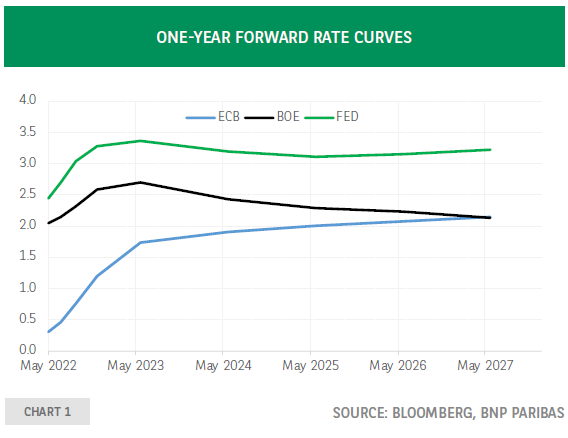Elevated inflation, if left unaddressed, could cause a de-anchoring of inflation expectations, an increase in risk premia, greater price distortion and hence longer-term costs for the economy. Although at first glance, central banks face a dilemma – hiking interest rates to lower inflation at the risk of causing an increase in unemployment or focusing on the labour market and accepting the risk that inflation stays high for longer –, they can only choose between acting swiftly or face an even bigger challenge later to bring inflation back under control. Recent statements by officials of the Federal Reserve, the ECB and the Bank of England acknowledge the need to act but their decisions and guidance are very different and reflect the differences in the macro environment.
In 2015, former Federal Reserve chair Ben Bernanke published ‘The courage to act: a memoir of a crisis and its aftermath’. The title springs to mind when watching the recent press conferences of Fed chair Jerome Powell and Bank of England governor Andrew Bailey1 as well as reading a recent speech of Banque de France governor François Villeroy de Galhau2.
Bernanke’s book provides great insight into the global financial crisis of 2008-2009, its causes, consequences and the policy action it necessitated. Today, the crisis is about elevated inflation and the longer-term cost it would entail if left unaddressed. There is clearly a need to act but it takes courage, considering that, firstly, part of the jump in prices is caused by a negative supply shock, which acts as a headwind to demand and, secondly, monetary tightening will slow down growth and may even cause an increase in the unemployment rate.
In this respect, A. Bailey was particularly clear. Although the unemployment rate in the UK is expected to decline further in the nearterm, to 3.6% in the second quarter, it is projected to reach 5.5% in three years’ time given the sharp slowdown in activity, to which monetary tightening will have contributed. J. Powell acknowledged that “there may be some pain associated with getting back to that [i.e. bringing inflation back to target]”3. This looks like a highly uncomfortable dilemma, but, according to the central bankers, the way to react is clear. “The big pain is in not dealing over time, is in not dealing with inflation, and allowing it to become entrenched.”4 A similar point was made by F. Villeroy de Galhau: “entrenched inflation would mean less confidence, higher risk premia, and greater price distortion, hence less long-term growth.”
Although the three central banks have a shared objective – bringing inflation under control –, markets expect their respective journeys to be very different (chart 1). This is a reflection of differences in terms of guidance and macro environment. Quoting A. Bailey, “the United States is facing what looks like a demand shock…, the euro area by contrast is facing a supply cost shock… and in the UK we’re seeing elements of both, like the euro area we’re experiencing a sharp terms of trade shock… but our strong labour market is more akin to that in the US.”
In the US, global supply shocks, strong demand and a very tight labour market force the Federal Reserve to tighten ‘expeditiously’5. After the 50bp rate hike at its May meeting, similar increases should follow at the next couple of meetings. Moreover, the reduction of the size of the balance sheet will start in June, although the economic effect is hard to assess with any precision.
In the euro area, the approach will be far more gradual. Compared to the US, the supply shocks play a bigger role, it is more exposed to geopolitical uncertainty caused by the war in Ukraine, wage growth is slower and the labour market is under less pressure than in the US. Based on recent statements of several ECB governing council members, a July hike of the deposit rate looks increasingly likely and more increases should follow.6
BNP Paribas is regulated by the FSA for the conduct of its designated investment business in the UK and is a member of the London Stock Exchange. The information and opinions contained in this report have been obtained from public sources believed to be reliable, but no representation or warranty, express or implied, is made that such information is accurate or complete and it should not be relied upon as such. This report does not constitute a prospectus or other offering document or an offer or solicitation to buy any securities or other investment. Information and opinions contained in the report are published for the assistance of recipients, but are not to be relied upon as authoritative or taken in substitution for the exercise of judgement by any recipient, they are subject to change without notice and not intended to provide the sole basis of any evaluation of the instruments discussed herein. Any reference to past performance should not be taken as an indication of future performance. No BNP Paribas Group Company accepts any liability whatsoever for any direct or consequential loss arising from any use of material contained in this report. All estimates and opinions included in this report constitute our judgements as of the date of this report. BNP Paribas and their affiliates ("collectively "BNP Paribas") may make a market in, or may, as principal or agent, buy or sell securities of the issuers mentioned in this report or derivatives thereon. BNP Paribas may have a financial interest in the issuers mentioned in this report, including a long or short position in their securities, and or options, futures or other derivative instruments based thereon. BNP Paribas, including its officers and employees may serve or have served as an officer, director or in an advisory capacity for any issuer mentioned in this report. BNP Paribas may, from time to time, solicit, perform or have performed investment banking, underwriting or other services (including acting as adviser, manager, underwriter or lender) within the last 12 months for any issuer referred to in this report. BNP Paribas, may to the extent permitted by law, have acted upon or used the information contained herein, or the research or analysis on which it was based, before its publication. BNP Paribas may receive or intend to seek compensation for investment banking services in the next three months from an issuer mentioned in this report. Any issuer mentioned in this report may have been provided with sections of this report prior to its publication in order to verify its factual accuracy. This report was produced by a BNP Paribas Group Company. This report is for the use of intended recipients and may not be reproduced (in whole or in part) or delivered or transmitted to any other person without the prior written consent of BNP Paribas. By accepting this document you agree to be bound by the foregoing limitations. Analyst Certification Each analyst responsible for the preparation of this report certifies that (i) all views expressed in this report accurately reflect the analyst's personal views about any and all of the issuers and securities named in this report, and (ii) no part of the analyst's compensation was, is, or will be, directly or indirectly, related to the specific recommendations or views expressed herein. United States: This report is being distributed to US persons by BNP Paribas Securities Corp., or by a subsidiary or affiliate of BNP Paribas that is not registered as a US broker-dealer, to US major institutional investors only. BNP Paribas Securities Corp., a subsidiary of BNP Paribas, is a broker-dealer registered with the Securities and Exchange Commission and is a member of the National Association of Securities Dealers, Inc. BNP Paribas Securities Corp. accepts responsibility for the content of a report prepared by another non-US affiliate only when distributed to US persons by BNP Paribas Securities Corp. United Kingdom: This report has been approved for publication in the United Kingdom by BNP Paribas London Branch, a branch of BNP Paribas whose head office is in Paris, France. BNP Paribas London Branch is regulated by the Financial Services Authority ("FSA") for the conduct of its designated investment business in the United Kingdom and is a member of the London Stock Exchange. This report is prepared for professional investors and is not intended for Private Customers in the United Kingdom as defined in FSA rules and should not be passed on to any such persons. Japan: This report is being distributed to Japanese based firms by BNP Paribas Securities (Japan) Limited, Tokyo Branch, or by a subsidiary or affiliate of BNP Paribas not registered as a financial instruments firm in Japan, to certain financial institutions permitted by regulation. BNP Paribas Securities (Japan) Limited, Tokyo Branch, a subsidiary of BNP Paribas, is a financial instruments firm registered according to the Financial Instruments and Exchange Law of Japan and a member of the Japan Securities Dealers Association. BNP Paribas Securities (Japan) Limited, Tokyo Branch accepts responsibility for the content of a report prepared by another non-Japan affiliate only when distributed to Japanese based firms by BNP Paribas Securities (Japan) Limited, Tokyo Branch. Hong Kong: This report is being distributed in Hong Kong by BNP Paribas Hong Kong Branch, a branch of BNP Paribas whose head office is in Paris, France. BNP Paribas Hong Kong Branch is regulated as a Licensed Bank by the Hong Kong Monetary Authority and is deemed as a Registered Institution by the Securities and Futures Commission for the conduct of Advising on Securities [Regulated Activity Type 4] under the Securities and Futures Ordinance Transitional Arrangements. Singapore: This report is being distributed in Singapore by BNP Paribas Singapore Branch, a branch of BNP Paribas whose head office is in Paris, France. BNP Paribas Singapore is a licensed bank regulated by the Monetary Authority of Singapore is exempted from holding the required licenses to conduct regulated activities and provide financial advisory services under the Securities and Futures Act and the Financial Advisors Act. © BNP Paribas (2011). All rights reserved.
Recommended Content
Editors’ Picks

AUD/USD Price Forecast: Revisits monthly high around 0.6390 Premium
AUD/USD advances to near 0.6390 despite the escalating trade war between the US and China. US President Trump announced a 90-day pause on reciprocal tariffs for all of his trading partners, except China. Trump’s tariff agenda has kept the US Dollar on the backfoot.

EUR/USD remains offered and below 1.1300
EUR/USD is feeling the squeeze, revisiting the area around 1.1280 as the US Dollar gains extra momentum on Tuesday. Mixed domestic data from Industrial Production and Economic Sentiment haven't done the Euro any favours either.

Gold embarks on a consolidative move around $3,200
Gold is holding its own on Tuesday, trading just above $3,200 per troy ounce as it bounces back from earlier losses. While a more upbeat risk sentiment is bolstering the rebound, lingering concerns over a deepening global trade rift have prevented XAU/USD from rallying too aggressively.

XRP, Dogecoin and Mantra traders punished for bullish bets, will altcoins recover?
Altcoins are recovering on Tuesday as the dust settles on US President Donald Trump’s tariff announcements last week. The President has repeatedly changed his mind on several tariff-related concerns, ushering volatility in Bitcoin and altcoin prices.

Is a recession looming?
Wall Street skyrockets after Trump announces tariff delay. But gains remain limited as Trade War with China continues. Recession odds have eased, but investors remain fearful. The worst may not be over, deeper market wounds still possible.

The Best brokers to trade EUR/USD
SPONSORED Discover the top brokers for trading EUR/USD in 2025. Our list features brokers with competitive spreads, fast execution, and powerful platforms. Whether you're a beginner or an expert, find the right partner to navigate the dynamic Forex market.
